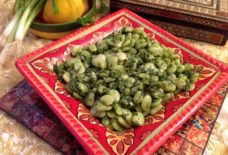Documentary sews Palestinian narrative through women's eyes
A still from “Stitching Palestine,” directed by Carol Mansour. (photo by Vimeo/Forward Film Production)In “Stitching Palestine,” 12 high-profile Palestinian women living in Lebanon, Jordan and Palestine tell the stories of their exile and their current lives, with the stitching of a piece of embroidery progressing as they tell their stories, linking one to another.
Mansour, founder of Forward Film Production, told Al-Monitor, “Four years ago, Muna and I started helping Inaash [Association for the Development of Palestinian Camps] for a project, which was about making 12 embroidery pieces to represent the 12 Palestinian regions [camps in Lebanon].” The project Mansour referred to is Twelve Windows of Palestine, conceived by embroidery collector Malak al-Hussaini Abdul-Rahim and carried out by embroiderers from Inaash.
Mansour further explained, “Inaash came to us to exhibit the 12 embroideries, but we ended up developing the idea slowly. We ended up recording the making of one piece that would connect 12 stories of women on Palestine.”
For making the documentary, Mansour and Khalidi benefited from a small grant from Taawon-Lebanon, a nonprofit organization providing development and humanitarian assistance to Palestinians in Palestine and Lebanon since 1983. Taawon also funded the Twelve Windows of Palestine.
“Stitching Palestine” features prominent women, including entrepreneurs, embroiderers and even a psychotherapist. “We chose women with a story to tell … coming from different backgrounds, having lived in different countries, professional and diverse women,” Khalidi told Al-Monitor. “Palestine’s story is made up of many stories, and the point of view of women is also more personal than the rest. They have a good life, but went through hard moments that a lot of people share and that resonates with the refugees nowadays. It is a global story of loss and displacement.”
One woman in the film, Dina Nasser, is a nurse and health adviser who lives in Jerusalem with her children. She cannot live with her husband, who resides elsewhere in the West Bank, because he has different legal residency. In the film, Nasser says, “They [Israeli officials] were telling me, ‘You don’t exist.’ We don’t exist? We are here, we exist.”
Mansour and Khalidi, both Palestinian, chose to make “Stitching Palestine” because they wanted to talk about an issue close to them in a way not typically seen in the media. Mansour noted, “There are a lot of films about Palestine, but it’s only about drama, about crying.” Khalidi added, “Also, the film allows women to speak for themselves. There is no scripting. It is to make people think and be curious.”
One memorable woman from “Stitching Palestine” is Leila Atshan, a psychotherapist who lives in Ramallah. She came to Beirut for the screening. In the film, she recalled stories of her mother, a very strong woman still present in her life. “I hope this movie will bring the issue of Palestine in a different way, through powerful women,” Atshan told Al-Monitor. “Women are easy to undermine, [but] they are the ones preserving the heritage, through embroideries for example, and society.”
Atshan was happy that the money raised from the screening would go to the children’s music program of Beit Atfal as-Somoud, an initiative founded in 2002 in collaboration with the Norwegian Academy of Music. “Children experiencing trauma and hardship, and even children whose parents went through exile, will inherit feelings such as a lack of confidence and predictability,” Atshan explained to Al-Monitor. “And I really think art can bring joy and relief to people in pain.”
Mahmoud Zeidan, director of the Rashidiyyah center, told Al-Monitor, “Music plays an important role for mental health and education. Music helps children suffering from depression or isolation, and also from school difficulties.”
More than 80 children from ages 6 to 18 attend free music lessons twice a week, studying violin, guitar, keyboard, saxophone, percussion, bass guitar and xylophone, along with vocalization and singing. They also learn the dabke, the Levantine folk dance. The program currently employs seven Palestinian music teachers.
“This camp is like a ghetto. There is only one gate,” Zeidan explained. “We have economic, health and work issues. There is no opportunity here. At least, from these times of music, children relax and gain some self-confidence.”
Erling Lorentzen Sogge, a doctoral fellow in the Department of Culture Studies and Oriental Languages at Oslo University, explained the importance of Palestinians living in Lebanon under harsh conditions having a space where they can enjoy themselves.
“The roughly 300,000 Palestinians that currently reside in Lebanon are subject to repressive law making, which has them living in the socio-economic margins of their host state,” Sogge told Al-Monitor. “On their fourth generation in Lebanon since the Nakba [or Catastrophe] of 1948, Palestinians still cannot own property, inherit or become Lebanese nationals while work permits are generally hard to come by. Around 56% of Palestinians in Lebanon are unemployed, while the number is closer to 90% for Palestinians coming from Syria. Even those who are able to find work are largely condemned to black labor, where job security and contracts are a rare thing. Therefore, it is perhaps not strange that roughly half of Lebanon’s Palestinians live within the country’s 12 official refugee camps, where many rely on the support offered by the UN’s Work and Relief Agency for Palestinians in the Near East.”
“Stitching Palestine” gives new voice to Palestine through the women it presents and, with the screening fundraiser at the Sofil, the film found a way to encourage other voices and allow them to perhaps find some relief for a time through music and dance.








